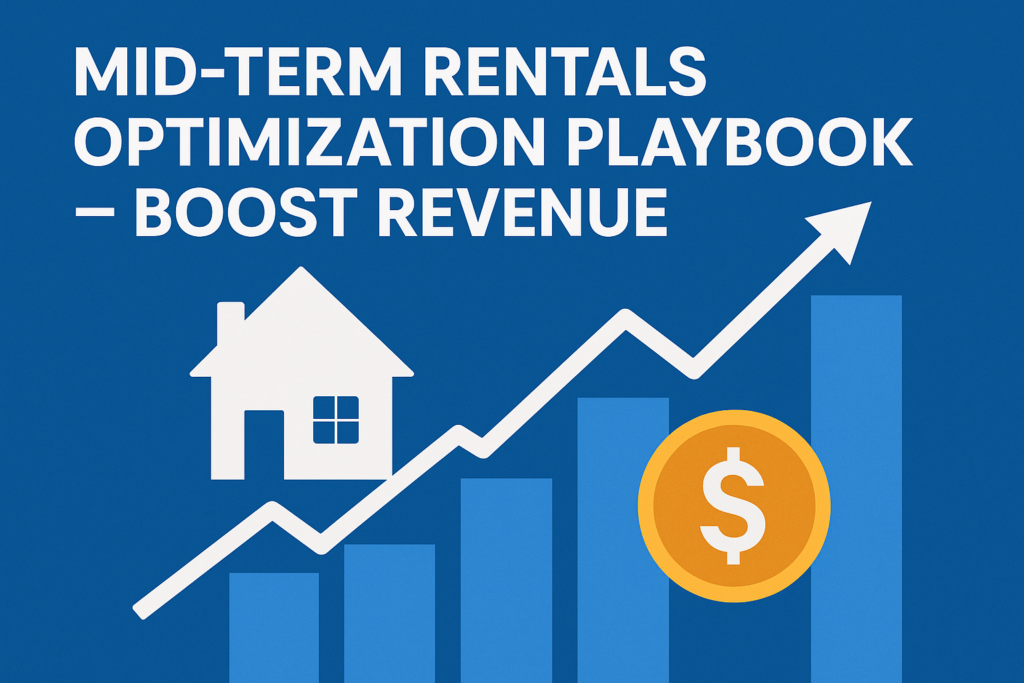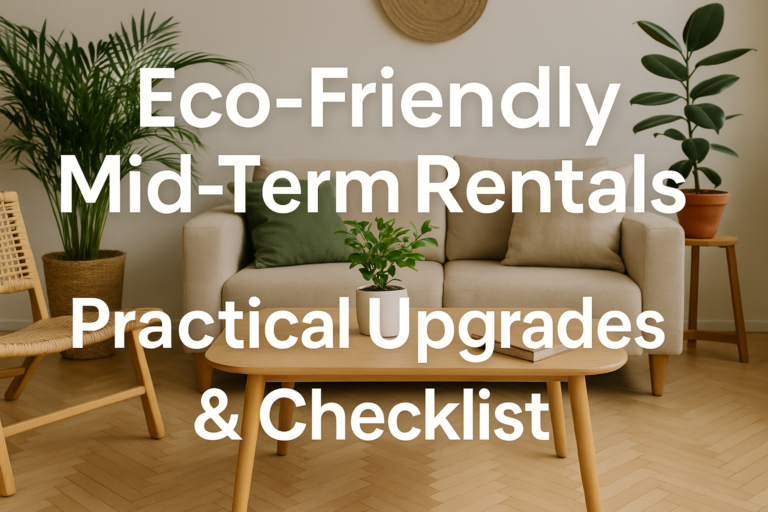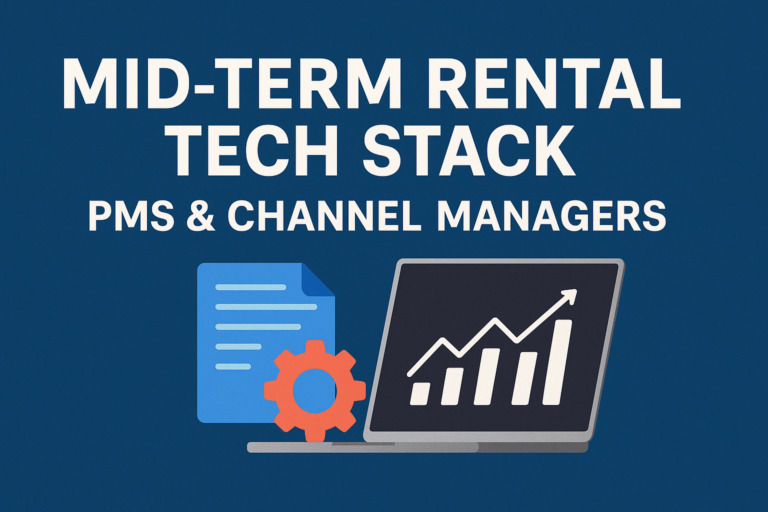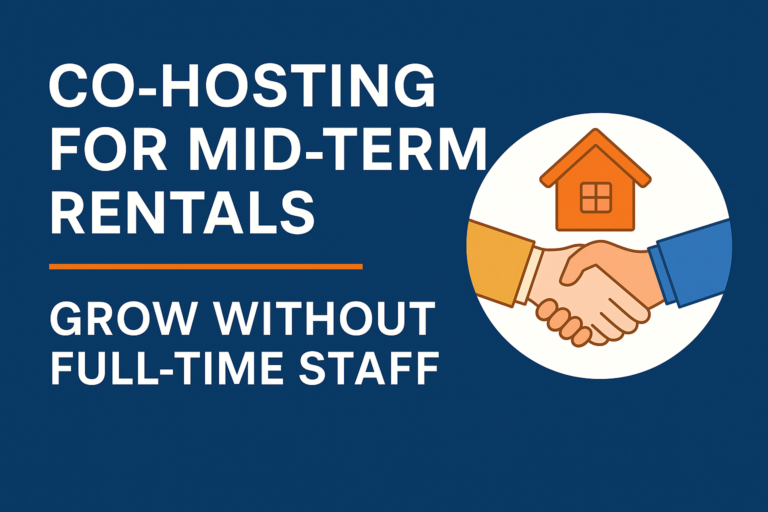Intro — what this mid-term rentals optimization playbook gives you
If you run furnished 30–180 day units, this mid-term rentals optimization playbook is the short list: concrete levers to raise revenue, cut repetitive operations, and keep guests longer. Read it, pick 2 changes, measure, repeat. The fastest wins come from pricing + automation + retention.
Start with a baseline: metrics this playbook uses
Before you optimize, measure. Track these weekly and monthly:
- Occupancy rate (target 70–90%)
- Average monthly rate (ARPU) net of platform fees
- Turnover cost per booking (cleaning + supplies + admin)
- Length of stay distribution (30–59 / 60–89 / 90+ days)
- Net operating income (NOI) per unit
- Lead → booking conversion rate
Set a simple dashboard (Google Sheet or BI) and update it every time you change price, cancellation rules, or guest policy.
Revenue: price smarter, not just higher
Small pricing changes beat heroic marketing.
- Use three clear tiers: 30–59 days, 60–89 days, 90+ days. Show the math in the listing.
- Compare local comps monthly (MiniStays, Airbnb, Zillow). Reprice the top and bottom 10% of your calendar.
- Offer extension incentives: 5–10% off for rolling 30-day renewals, or a fixed credit for a 90+ extension.
- Discount by occupancy gaps, not by calendar days: if you have a 45% occupancy week, lower the 60+ price briefly to attract a mid-length stay.
- Test promotions as experiments (A/B): one listing with a 60-day discount vs one without. Track rebooking and NOI.
Pro tip: present pricing advantages clearly in the listing headline and lead bullets — guests absorb monthly math faster than nightly rates.
Cut ops: automate the repeatable, document the rest
Ops kills scale. Fix it.
- Convert every repeat task into a one-line SOP and a checklist (listing creation, check-in, cleaner handoff, maintenance triage).
- Automate three workflows first: booking → cleaner task, booking → welcome message, checkout → cleaner report + deposit evaluation. Use Zapier / Make or your PMS.
- Outsource predictable work: VA for messaging, a local cleaner panel (2 pros + backup), a part-time bookkeeper. Pay for outcomes, not hours.
- Keep SOPs short and visual (screenshots, 3–5 step videos). Train via a single run-through and one follow-up QA.
If a task still needs your attention after automating, it probably needs a better SOP — not your time.
Convert guests into repeat bookings (retention playbook)
Retention cuts CAC and vacancy.
- Offer simple extension paths: “Extend 30 days at $X or 60 days at $Y — reply to this message.” Automate the offer 14 days before checkout.
- Build a guest CRM (even a Google Sheet): record guest preferences, Wi-Fi performance, work hours, and any special notes the guest liked. Use that in welcome messages.
- Loyalty perks: 5% off for returning guests, or a referral credit. Make it easy and instant.
- Deliver a consistent on-site experience: fast Wi-Fi, a dedicated workspace, clear check-in instructions, and a small welcome pack. Repeat guests remember the basics.
Retention KPI: % of checkouts who extend or rebook within 90 days.
Tech & tools that actually move the needle
You don’t need every tool; you need the right stack.
- Small portfolios (1–4 units): Zapier/Make + Google Sheets + calendar + messaging templates.
- Growing (5–10 units): PMS with channel management (Hostfully, Lodgify, Hostaway) and basic accounting integration.
- Reporting: QuickBooks + a one-page dashboard updated automatically via Zapier or your PMS export.
- Always require tools to integrate (webhooks/APIs). If they don’t, skip them.
Focus: automation that saves owners hours per booking and prevents double-booking.
Operations playbook: SOPs you should have day one
Create one-page SOPs for:
- Listing creation (title, top 5 bullets, photo order)
- Guest screening & verification checklist
- Cleaner turnover checklist + photo requirements
- Maintenance triage (photo → assess → vendor)
- Check-in & check-out flow with timings and contact points
Convert each SOP into a task template in your PMS or task tool and assign it automatically on booking.
Marketing & distribution: bring the right guests, not just more guests
Less churn starts with better targeting.
- List on MiniStays for 30+ demand; mirror to Airbnb for overflow. Use Furnished Finder only if you target nurses.
- Build one city landing page per market and link to 4–6 listings there. That improves organic visibility for local searches.
- Run low-waste PPC for intent (search terms like “monthly furnished rental [city]”) and track cost per booked month.
- Partner with hospitals, relocation firms, and local employers for recurring lead flow.
Anchor to your cluster posts: detailed SEO and distribution tactics are in Mid-Term Rental Marketing & SEO: How to Get Booked Faster.
Protect revenue: contracts, insurance & compliance in your playbook
Optimization without protection is fragile.
- Use a mid-term lease with clear extension and deposit rules.
- Require or recommend renter’s insurance for longer stays.
- Buy mid-term rental insurance and umbrella liability; keep COIs for corporate bookings.
- Confirm local registration, taxes, and HOA rules before listing.
For deeper compliance and insurance playbooks, see Insurance, Liability & Local Compliance for Mid-Term Rentals.
Playbook roll-out: one change at a time for mid-term optimization
Pick one revenue lever, one automation, and one retention tweak. Run for 6–8 weeks, measure, then roll forward.
Sample 90-day plan:
- Week 0: baseline dashboard + pricing tiers.
- Week 1–4: automate booking → cleaner + add welcome message.
- Week 5–8: test 60-day discount and auto-extension offer.
- Week 9–12: review KPIs; roll successful changes portfolio-wide.
Quick checklist — implement mid-term rentals optimization this week
- Create three price tiers and publish them in your listing.
- Build one automation: booking → cleaner task.
- Add an automated extension offer at day −14 from checkout.
- Make a one-page SOP for turnover and train your cleaner.
- Run a MiniStays search for your city to benchmark pricing.
Cluster posts (read next — deep dives in the optimization playbook)
- Advanced Yield Management for Mid-Term Rentals: Dynamic Pricing That Works
- Guest Retention & Loyalty for Mid-Term Rentals: Extensions, CRM & Offers
- B2B & Corporate Housing: Win Contracts for 30+ Day Stays
- Co-Hosting & Local Property Partnerships: Grow Without Full-Time Staff
- Tech Stack That Scales: PMS, Channel Managers & Integrations for Mid-Term Hosts
- Sustainability, Accessibility & Community Relations for Mid-Term Rentals
FAQs — mid-term rentals optimization playbook (short answers)
Q: How fast will automation pay for itself?
A: Often within 2–3 months for a 3–5 unit portfolio — saved hours plus fewer missed cleanings and bookings.
Q: How deep should my SOPs be?
A: One page, with 5–10 steps and photos. Keep them actionable, not theoretical.
Q: Where should I test pricing changes?
A: On one representative unit in your top market. Use MiniStays and one other platform for comparison.
Final word & where to list — use the mid-term rentals optimization playbook
Optimization is iterative. Follow the mid-term rentals optimization playbook: measure first, automate second, then scale retention. If you want a platform built for 30+ day stays that attracts vetted professionals and helps you test pricing and demand, list on MiniStays.
Start hosting on MiniStays → https://ministays.com



